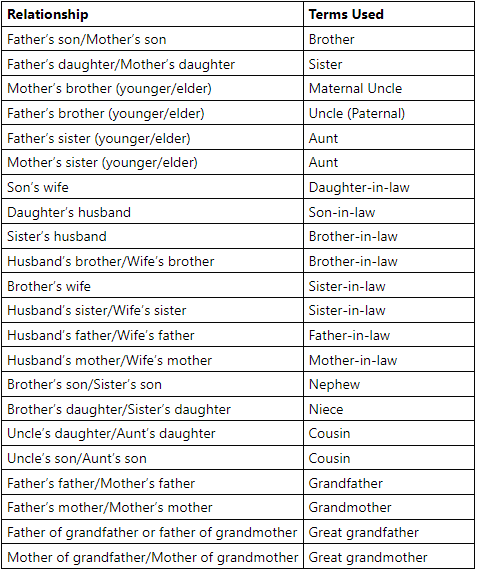Introduction: Blood Relations | Reasoning and Military Aptitude Test for AFCAT PDF Download
What is Blood Relation?
Blood Relation refers to the connection between two individuals established through their birth rather than through marriage or any other factors. Blood Relation questions entail the analysis of information depicting the familial relationships among its members. In these questions, a series of relationships is presented in informational form, and candidates are required to determine the relationship between two members of the family based on this provided information.
Candidates need to be acquainted with the hierarchical structure of the family, typically spanning three generations above and three generations below the current generation. In essence, Blood Relation reasoning involves inquiries aimed at identifying relationships among family members. Using the provided information, candidates must deduce relationships, such as those by birth (e.g., mother, father, son, daughter) or by marriage (e.g., father-in-law, mother-in-law, sister-in-law).
Types of Blood Relation
Now that we have an understanding of what constitutes a Blood Relation reasoning section, let's explore the various types of Blood Relation reasoning questions individually.
Pointing or Introducing
- In these pointing or introducing questions, an individual indicates or introduces someone through conversation or by other means. Candidates are tasked with identifying the relationship between the individuals. To illustrate, consider the following example of a blood reasoning question:
Example: Rahul points to a lady and says, “She is the wife of my mother’s father’s only grandchild.” How is that lady related to Rahul?
Solution: By constructing the family tree, we can deduce that Rahul's mother's father is his grandfather. The only grandchild of Rahul's grandfather is a male (Rahul himself), making the lady the wife of Rahul. Therefore, the correct answer is "Wife."
Family Tree
- In these Blood Relation reasoning questions, information about the relationship between different family members is provided, and candidates are asked to determine the relationship between any two of them. This type of question is also known as "by law" or "by blood" Blood Relation reasoning.
Example: Rahul is Mohan's son. Hari is Manu's father. Rahul is married to Dina. Rahul and Manu are siblings. Kanav is Dina's brother. Mohan has only one son. Neha is Rahul's child. Kanav is Akash's father. What is the relationship between Kanav and Akash, respectively?
Solution: Upon careful examination, we find that Kanav is Akash's father, but Akash's gender is not specified. Therefore, the correct answer is "Cannot be determined" based on the given statements.
Coded Relation
- In this category of blood relation questions, family members are denoted by specific codes or symbols, such as +, $, *, &, #, @, !, etc. Candidates are required to decipher the symbols or codes to arrive at the accurate relationships.
- Example: First consider the below statements carefully.
P $ Q implies that P is the sister of Q
P % Q implies that P is the brother of Q
P & R implies that P is the mother of R
P @ S implies that P is the son of S
Now find out the relationship between F and D from the following expression such as D % C @ G $ H $ F
Solution: The above statements implies the following things. So by analysing the above table we can deduce the above expression D % C @ G $ H $ F as “D is the brother of C”, “C is the son of G”, “G is the sister of H”, and “H is the sister of F”. The gender of F is unknown. So F can be either uncle or aunt of D. Therefore, the correct response for this question will be “Uncle or Aunt”.
So by analysing the above table we can deduce the above expression D % C @ G $ H $ F as “D is the brother of C”, “C is the son of G”, “G is the sister of H”, and “H is the sister of F”. The gender of F is unknown. So F can be either uncle or aunt of D. Therefore, the correct response for this question will be “Uncle or Aunt”.
Given below is the list of some different types of relation which are most commonly asked in this blood relation reasoning section in various Govt. exams. Have a look at them to be more familiar with these various relations.

|
85 videos|62 docs|68 tests
|
FAQs on Introduction: Blood Relations - Reasoning and Military Aptitude Test for AFCAT
| 1. What is blood relation? |  |
| 2. What are the types of blood relations? |  |
| 3. How are blood relations important in solving logical reasoning problems? |  |
| 4. What are some common blood relation problems asked in competitive exams? |  |
| 5. What are some tips to solve blood relation problems effectively? |  |





















